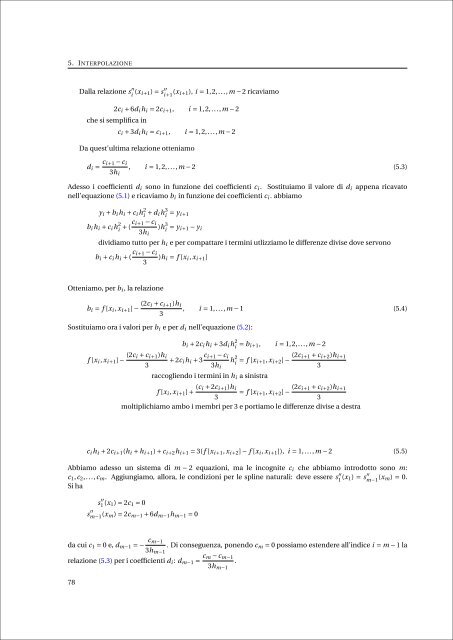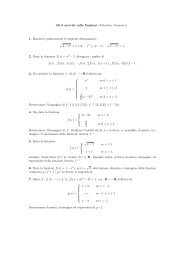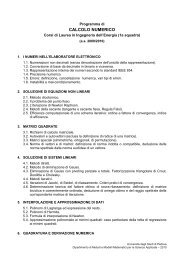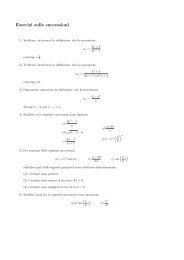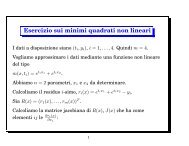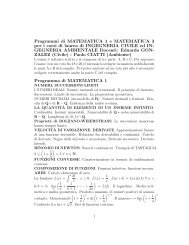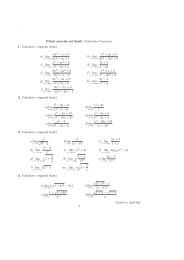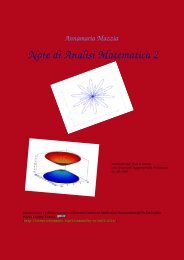Appunti di Calcolo Numerico - Esercizi e Dispense - Università degli ...
Appunti di Calcolo Numerico - Esercizi e Dispense - Università degli ...
Appunti di Calcolo Numerico - Esercizi e Dispense - Università degli ...
You also want an ePaper? Increase the reach of your titles
YUMPU automatically turns print PDFs into web optimized ePapers that Google loves.
5. INTERPOLAZIONE<br />
Dalla relazione s ′′<br />
i (x i+1) = s ′′<br />
i+1 (x i+1), i = 1,2,...,m − 2 ricaviamo<br />
2c i + 6d i h i = 2c i+1 , i = 1,2,...,m − 2<br />
che si semplifica in<br />
c i + 3d i h i = c i+1 , i = 1,2,...,m − 2<br />
Da quest’ultima relazione otteniamo<br />
d i = c i+1 − c i<br />
3h i<br />
, i = 1,2,...,m − 2 (5.3)<br />
Adesso i coefficienti d i sono in funzione dei coefficienti c i . Sostituiamo il valore <strong>di</strong> d i appena ricavato<br />
nell’equazione (5.1) e ricaviamo b i in funzione dei coefficienti c i . abbiamo<br />
y i + b i h i + c i h 2 i + d i h 3 i = y i+1<br />
b i h i + c i h 2 i + ( c i+1 − c i<br />
)h 3 i<br />
3h = y i+1 − y i<br />
i<br />
<strong>di</strong>vi<strong>di</strong>amo tutto per h i e per compattare i termini utlizziamo le <strong>di</strong>fferenze <strong>di</strong>vise dove servono<br />
b i + c i h i + ( c i+1 − c i<br />
3<br />
)h i = f [x i , x i+1 ]<br />
Otteniamo, per b i , la relazione<br />
b i = f [x i , x i+1 ] − (2c i + c i+1 )h i<br />
3<br />
Sostituiamo ora i valori per b i e per d i nell’equazione (5.2):<br />
f [x i , x i+1 ] − (2c i + c i+1 )h i<br />
3<br />
, i = 1,...,m − 1 (5.4)<br />
b i + 2c i h i + 3d i h 2 i = b i+1, i = 1,2,...,m − 2<br />
+ 2c i h i + 3 c i+1 − c i<br />
h 2 i<br />
3h = f [x i+1, x i+2 ] − (2c i+1 + c i+2 )h i+1<br />
i 3<br />
raccogliendo i termini in h i a sinistra<br />
f [x i , x i+1 ] + (c i + 2c i+1 )h i<br />
= f [x i+1 , x i+2 ] − (2c i+1 + c i+2 )h i+1<br />
3<br />
3<br />
moltiplichiamo ambo i membri per 3 e portiamo le <strong>di</strong>fferenze <strong>di</strong>vise a destra<br />
c i h i + 2c i+1 (h i + h i+1 ) + c i+2 h i+1 = 3(f [x i+1 , x i+2 ] − f [x i , x i+1 ]), i = 1,...,m − 2 (5.5)<br />
Abbiamo adesso un sistema <strong>di</strong> m − 2 equazioni, ma le incognite c i che abbiamo introdotto sono m:<br />
c 1 ,c 2 ,...,c m . Aggiungiamo, allora, le con<strong>di</strong>zioni per le spline naturali: deve essere s<br />
1 ′′(x<br />
1) = s<br />
m−1 ′′ (x m) = 0.<br />
Si ha<br />
s ′′<br />
1 (x 1) = 2c 1 = 0<br />
s ′′ m−1 (x m) = 2c m−1 + 6d m−1 h m−1 = 0<br />
da cui c 1 = 0 e, d m−1 = − c m−1<br />
3h m−1<br />
. Di conseguenza, ponendo c m = 0 possiamo estendere all’in<strong>di</strong>ce i = m − 1 la<br />
relazione (5.3) per i coefficienti d i : d m−1 = c m − c m−1<br />
3h m−1<br />
.<br />
78


